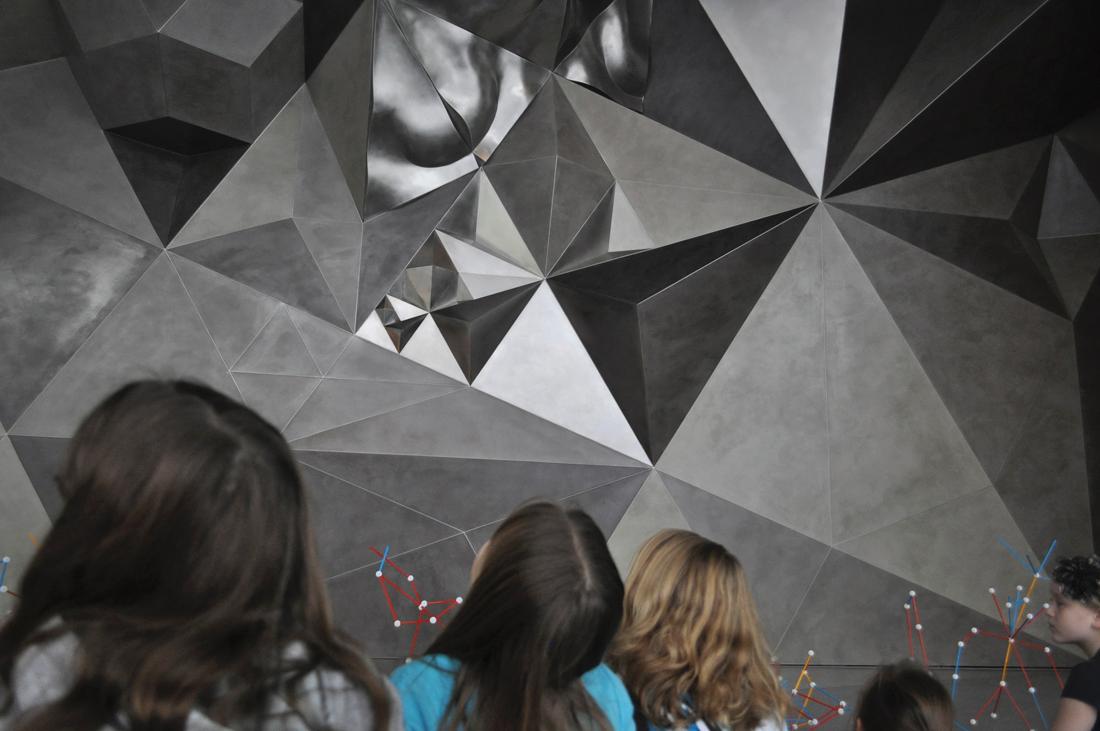Passacaglia exhibit bridges gap between math and art
Passacaglia is an 11-letter mouthful that describes baroque dance music of Italian or Spanish origin. It is also the name of the looming, steel sculpture that graces the lobby of the Performance Hall.
On Jan. 18, as part of Celebrate the Arts Week, the Nora Eccles Harrison Museum of Art will open its exhibit “Passacaglia: A Spotlight on Sculpture.” Though the sculpture has been in place for four years, the exhibition will provide an in-depth look into its complex construction, said Deborah Banerjee, the museum’s curator of exhibitions and programs.
“The sculpture is an integral part of the building but also a piece of art in its own right,” Banerjee said.
The size of the protruding Passacaglia parallels its name in length. The 50-by-28 creation was completed by artist Ann Preston and her fabrication team in September 2007. Nadra Haffar, education curator of the Nora Eccles Harrison Museum of Art, said the piece took nearly two years with two long summers to complete.
“Often, people don’t understand that something that massive has to be handed over to another crew of fabricators and engineers,” Haffar said. Preston worked with L.A.’s Knack Studios in the construction of Passacaglia.
“(Preston) had her hand in it quite a bit,” Banerjee said.
“Ann Preston is one of the strangest, most inspired, reclusive and underrated artists working in Los Angeles,” according to a 1993 review in Artforum International magazine by Benjamin Weissman. Preston was born in Seattle in 1942. In 1968, she earned her Bachelor of Fine Arts from Tufts University in Boston and in 1980, her Master of Fine Arts from California Institute of the Arts in Valencia, Calif. She is married to a math professor. When Passacaglia was completed, Preston lectured on campus about the intricate math involved in creating her sculpture.
“She’s a fascinating artist because she does sculpture in a way that reflects mathematics,” Banerjee said.
“(Passacaglia) also offers this contrast between the geometric and the organic,” Haffar said. “As human beings we’re always combining those two things.” Haffar said the harsh structures of architecture itself in the setting of nature are an example of this combination. Banerjee described Preston’s style as a blend of the precise order of the golden mean with organic chaos and said Preston often begins designs with tessellations.
Banerjee said Preston’s Passacaglia is a one-of-a-kind piece, though Preston has developed other similar stand-alone pieces, “which recall gems turned inside out,” according to an Artforum.com review by Cassie Wu in February 2010.
Passacaglia is constructed of large cast stainless steel sectors welded together and wooden segments covered with a tinted, plaster-like acrylic finish. Banerjee called it a mix between sculpture and painting. Both Banerjee said Preston worked with the architects of the Performance Hall and that Passacaglia technically extends further than the wall out of which it grows; the tile floor, windows and cement in front of the Performance Hall are in fact the limbs of the sculpture.
The underlying structure of Passacaglia is made of construction framing materials. The pieces were fitted, grinded and welded into place, a sort of skeleton that grows out of the metal into a defined shape, “almost a body part,” Banerjee said.
As part of the exhibition, donated Zometools are available for guests to model into geometric creations. Zometools are a type of constructive tinker toy that Preston used extensively in her designs of Passacaglia.
“It’s kind of an unusual show,” Banerjee said, referring to the dominant inclusion of so much architecture. Part of the exhibit is a slide show that follows the step-by-step design and installation of Passacaglia.
“There’s a lot that that piece gives us,” Haffar said. The exhibit is up through August in the study center of the Nora Eccles Harrison Museum of Art.
The geometric features of Passacaglia are so apparent that it is used as an object lesson on the connection between art and mathematics for elementary to university students, Haffar said. In March, there will be a professional development teacher workshop to learn more about the Zometools and math and science core and how to integrate it into teaching. For more information, contact Haffar at nadra.haffar@usu.edu.
– noelle.johansen@aggiemail.usu.edu

